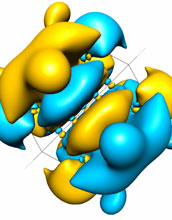Multimedia Gallery
Calculated electronic state of the excited electron of a silicon nanocrystal
A model of the calculated electronic state of the excited electron of a silicon nanocrystal.
The orbits electrons use to travel around the nucleus of an atom are complicated in shape. Each orbit can hold no more than two electrons. When atoms come together to form a molecule like this silicon nanocrystal, the electrons that previously were orbiting each atom now travel throughout the entire molecular structure, getting close to multiple atoms and forming even more complicated shapes. The blue and yellow shapes here are like clouds within which an electron could be found. The plot shows where the two most energetic electrons of the silicon nanocrystal orbit.
[Research supported by U.S. National Science Foundation grants DMR 0102668 and DMR 0121361.] (Year of image: 2002)
Credit: Zack Helms/Quantum Simulations Laboratory, North Carolina State University; simulations completed using computational resources provided by the National Center for Supercomputing Applications
Images and other media in the National Science Foundation Multimedia Gallery are available for use in print and electronic material by NSF employees, members of the media, university staff, teachers and the general public. All media in the gallery are intended for personal, educational and nonprofit/non-commercial use only.
Images credited to the National Science Foundation, a federal agency, are in the public domain. The images were created by employees of the United States Government as part of their official duties or prepared by contractors as "works for hire" for NSF. You may freely use NSF-credited images and, at your discretion, credit NSF with a "Courtesy: National Science Foundation" notation.
Additional information about general usage can be found in Conditions.
Also Available:
Download the high-resolution JPG version of the image. (427 KB)
Use your mouse to right-click (Mac users may need to Ctrl-click) the link above and choose the option that will save the file or target to your computer.



 All images in this series
All images in this series